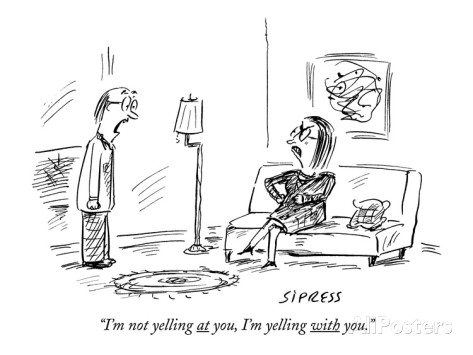I think that a large degree of Chef Gordon Ramsey’s bark is a whole lot of bluff. Add a pulsing forehead vein, a few a bleepity bleep bleeps from the network censor, some sweaty and terrified wannabe chefs, and a crab-stuffed filet mignon in peppercorn sauce and you’ve got an hour of entertainment. To what extent are his astronomical anger management issues fabricated for ratings? My guess would be a whole lot. Still, wouldn’t it be fun to imagine that he was part of some underground organization called the Verbal Fight Club, where frenzied arguments would go on in the depths of an abandoned warehouse? Each fighter hurls insults at the other. The fight ends when someone cries.
So what kind of tactics do dirty fighters use? Here is what data from Queendom’s Arguing Style Test reveals:
It’s what they say AND how they say it
93% of “un-constructive” fighters raise their voice during an argument, making it difficult to get a word in edgewise. Unfortunately, 86% also have a tendency to resort to swearing or name-calling, while 92% “hit below the belt” in an attempt to find the most hurtful thing they can say or use against their partner.
It’s the holier-than-thou attitude
Aside from the fact that 28% of un-constructive fighters refuse to acknowledge when their partner makes a valid point, another 32% refuse to admit when they’re wrong – even when they know they are wrong – and 71% refuse to be the first one to apologize after a fight. A whopping 92% would rather win a fight than find a mutually beneficial solution.
It’s the tendency to never let bygones be bygones
During arguments, 90% of un-constructive fighters allow old grudges to resurface. More specifically, 88% will bring up issues that were resolved years ago, while 85% use fights as an excuse to bring up everything that’s bothering them.
It’s the unwillingness to recognize their own issues
You know what they say: Rocks + glass houses, pot + cauldron, sins + casting stones. 83% of un-constructive fighters tell their partners what they need to do fix their problem. Sadly, it’s easy to criticize other people or blame our problems on them; it’s so much harder to admit our own faults.
Another 85% of unconstructive fighters point out their partner’s character flaws instead of focusing on the behavior that they are having an issue with. For example:
- “You’re an awful father!” = Character flaw
- “I don’t agree with the way you deal with our kids.” = Behavior
- “You’re lazy! I always have to do everything around the house!” = Character flaw
- “I wish you would help me out around the house more often.” = Behavior
While I am poking a little fun at people who resort to fighting dirty, I am the first one to admit that conflict-resolution is NOT one of my strengths. You see, my goal is always to stay cool and calm, letting the other person vent like an angry, gassy giant until they run out of steam. What I actually end up doing is walking out of the room while the person is in mid-sentence. Then I’ll sit up in bed all night replaying the situation in my head, coming up with a bunch of witty comments I wish I had thought of then, and kicking myself for being such a jellyfish (not the cool ones that can sting; those useless ones that just float there).
Those who read my blog regularly know that I never offer advice while sitting on a proverbial high horse – I’m right down there in the trenches with you.
Ground rules for constructive fighting – DING DING DING!
Avoiding confrontation altogether is not the easy way out.
Holding onto your anger results in a build up of unresolved frustration. Sulking and denial do not accomplish anything, as your partner might interpret your avoidance of an argument as a lack of interest in the issues that affect your relationship. Like a little kid whose had one too many slurpies, a build-up of frustration always finds a way out to squirt out, often at the most inopportune times.
Find common ground.
Begin by pointing out things that you can agree on. Even if you have opposing point of views, there will likely be a few items you see eye-to-eye on. This tactic builds a bridge between you and your partner and creates a working atmosphere that focuses on a shared goal.
Tell your partner exactly what is on your mind.
Don’t try to hide your emotions by being vague (ladies, I’m talking to you). For example, don’t yell at your partner for leaving the dishes in the sink when what you’re really upset about is the fact that he/she spends too much time at work. Be clear about why you’re upset. Otherwise you’ll never be able to resolve the real issue.
Try to understand how your partner sees the situation.
Put yourself in his or her shoes. Ask your partner for their version of the story and listen with an open mind. We tend to focus on our own interpretation of events. Try to see things from your partner’s perspective and you’ll gain a more thorough view of the issue. Just like you, your partner has the right to see things differently.
Realize that some issues just can’t be resolved in one argument.
If you dealing with a touchy, complex issue (like infidelity), make sure that you both understand that the topic will have to be addressed again and again. If there doesn’t seem to be any progress being made, or if you feel like you’re going in circles, consult a professional who can help guide you through your issue.
Insightfully yours,
Queen D


